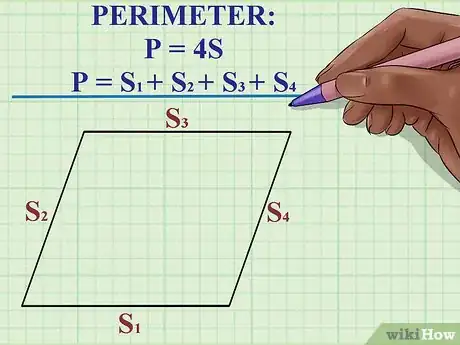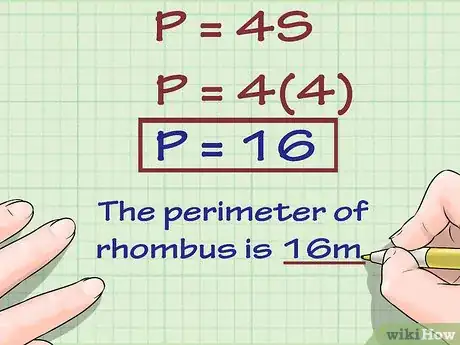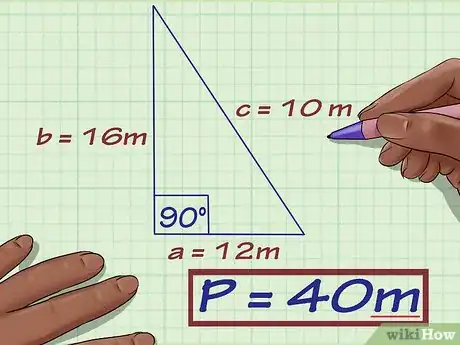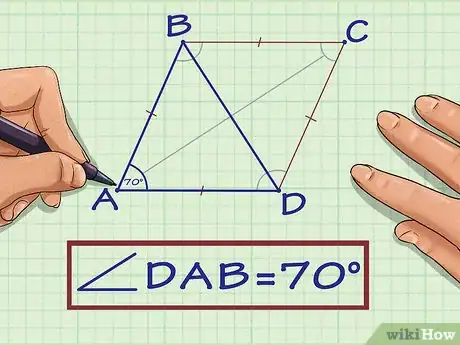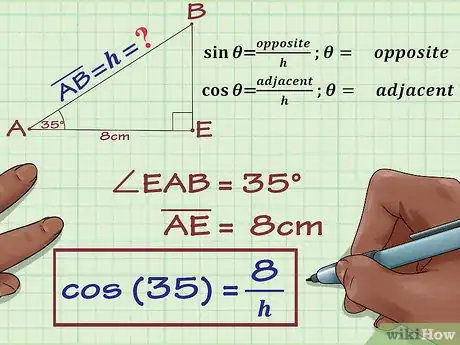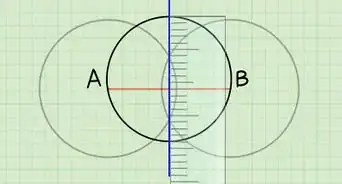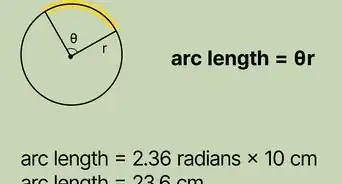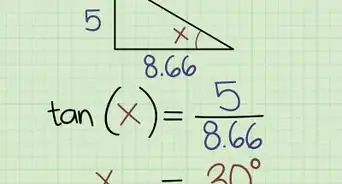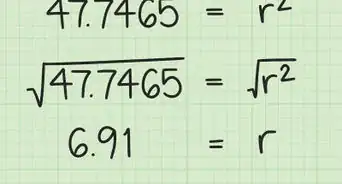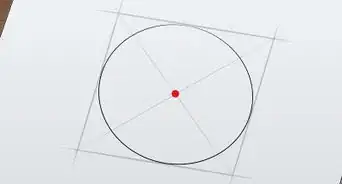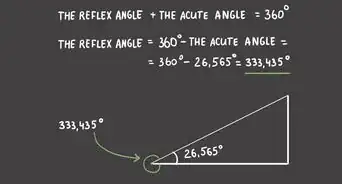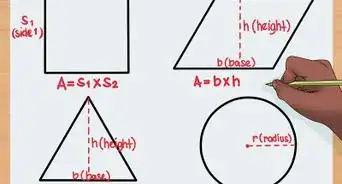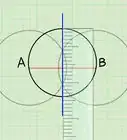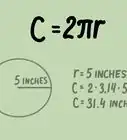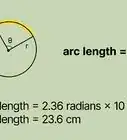This article was co-authored by wikiHow Staff. Our trained team of editors and researchers validate articles for accuracy and comprehensiveness. wikiHow's Content Management Team carefully monitors the work from our editorial staff to ensure that each article is backed by trusted research and meets our high quality standards.
There are 7 references cited in this article, which can be found at the bottom of the page.
This article has been viewed 99,948 times.
Learn more...
A rhombus is a parallelogram with four congruent sides.[1] These properties allow for numerous methods for finding the perimeter. Since all four sides of a rhombus are of equal length, finding the perimeter is possible when one side length is known. However, using geometry and trigonometry, it is also possible to find the perimeter even if you do not know the lengths of any sides of the rhombus.
Steps
Using Side Length
-
1Set up the formula for perimeter of a rhombus. Since, by definition, all four sides of a rhombus are the same length, the formula is , where equals the perimeter, and equals the length of one side.[2]
- You could also use the formula to find the perimeter, since the perimeter of any polygon is the sum of all its sides.[3]
- If you know that not all sides are the same length, then you are not working with a rhombus, and you cannot use this formula.
- If you don’t know the length of any side of the rhombus, you cannot use this method.
- A square is a special type of rhombus, with four 90-degree angles.
-
2Plug in the side length of the rhombus. Make sure you are substituting for the variable .
- For example, if you know one side of the rhombus is 4 meters long, your formula will look like this: .
Advertisement -
3Solve for . To do this, multiply by 4.
- For example:
So, the perimeter of the rhombus is .
- For example:
Using Length of Diagonals
-
1Notice that the two diagonals of your rhombus create four congruent triangles. Outline one of these triangles. You will use it to find the length of one side of the rhombus.
- Since the triangles are congruent, it doesn’t matter which one you outline.
-
2Identify the 90 degree angle of your triangle. The two diagonals of a rhombus are perpendicular, so the central angle of your triangle will be 90 degrees. [4]
-
3Label the hypotenuse of your triangle. The hypotenuse is the side opposite a 90 degree angle.[5] Traditionally, the hypotenuse is labeled .
- The hypotenuse of your triangle is one side of the rhombus. So, if you find the length of , you will know the length of one side of the rhombus.
-
4Label the other two sides of your triangle. Traditionally, these are labeled and .
-
5Find the length of side . To do this, divide the length of the diagonal that runs along by 2. Label the side length on your triangle.
- Since the diagonals of a rhombus bisect each other, you know that the length on either side of their intersection will be equal.[6] Since side is half the length of the diagonal, you can find its length by dividing the diagonal length in half.
- For example, if side runs along a diagonal that is 12 meters long, you can find the length of side by calculating:
-
6Find the length of side . To do this, divide the length of the diagonal that runs along by 2. Label the side length on your triangle.
- For example, if side runs along a diagonal that is 16 meters long, you can find the length of side by calculating:
- For example, if side runs along a diagonal that is 16 meters long, you can find the length of side by calculating:
-
7Set up the Pythagorean Theorem. The theorem states that . This is a basic geometric formula for finding the side lengths of a right triangle.
-
8Plug in the known side lengths of your triangle into the Pythagorean Theorem. Make sure you substitute for and , but the order doesn’t matter due to the commutative property.
- For example, if and , your equation will look like this: .
-
9Solve for . To do this, you need to square and , add, then find the square root of the sum.
- For example:
- For example:
-
10Multiply by four. Since the hypotenuse is also the side of the rhombus, to find the perimeter of the rhombus, you need to plug the value of into the formula for the perimeter of a rhombus, which is , where equals the length of one side of the rhombus. In this case, it is the same value that we found for .
- For example:
- For example:
-
11Write your final answer. Don’t forget to include the correct unit of measurement.
- For example, a rhombus that has diagonals measuring 12 and 16 meters long has a perimeter of 40 meters.
Using One Diagonal and One Angle
-
1Label the vertices of your rhombus, if they are not already labeled. It doesn’t matter which variables you give them.
- The vertices (singular vertex) are the corners of the rhombus.
- For example, you might label the vertices , , , and .
-
2Notice that the two diagonals of your rhombus create four congruent triangles. Outline one of these triangles. You will use it to find the length of one side of the rhombus.
- Since the triangles are congruent, it doesn’t matter which one you outline; however, for simplicity you should outline a triangle that shares a known angle of the rhombus.
- For example, I know that angle of the rhombus is 70 degrees, so I would outline a triangle that includes point A.
-
3Identify the 90 degree angle of your triangle. The two diagonals of a rhombus are perpendicular, so the central angle of your triangle will be 90 degrees. [7] If this angle is not already labeled, label it .
-
4Determine the measurement of angle . Remember that the diagonals of a rhombus bisect its vertices.[8] So, if you know the measurement of angle of the rhombus, divide it in half to find the measurement of angle of the triangle. Label the degrees for this angle on your triangle.
- This method will not work if you do not know the measurement of at least one vertex of your rhombus.
- For example, you know angle of the rhombus is 70 degrees, so the angle of the triangle is half that, or 35 degrees.
-
5Determine the measurement of the missing angle. Remember, the interior degrees of a triangle will add up to 180.[9] So, if you know the measurement of two angles, you can subtract to find the measurement of the third angle. Label the degrees for this angle on your triangle.
- For example, you know that angle is 90 degrees, and angle is 35 degrees. To find the third angle, sum the two angles you already know, then subtract that sum from 180.
So, the measurement of angel is 55 degrees.
- For example, you know that angle is 90 degrees, and angle is 35 degrees. To find the third angle, sum the two angles you already know, then subtract that sum from 180.
-
6Determine the length of one side of your triangle. To do this, divide the length of the diagonal that the side runs along by 2. Label the side length on your triangle.
- Since the diagonals of a rhombus bisect each other, you know that the length on either side of their intersection will be equal.[10]
- This method will not work if you do not know the length of at least one diagonal of your rhombus.
- For example, if you know that diagonal is 16 centimeters, you can divide 16 in half to find the length of side of your triangle. , so side is .
-
7Set up a sine or cosine ratio. Whether you use sine or cosine will depend on which side and angle measurements of your triangle you know. For more information, read Use Right Angled Trigonometry.
- If you know the length of the side opposite to your angle, use sine. Set up the ratio , where is the measurement of the angle, “Opposite” is the length of the opposite side, and is the length of the hypotenuse.
- If you know the length of the side adjacent to your angle, use cosine. Set up the ratio . Where is the measurement of the angle, “Adjacent” is the length of the adjacent side, and is the length of the hypotenuse.
- For example, if you know that angle of your triangle is 35 degrees, and the adjacent side is 8 centimeters, you should use cosine:
-
8Solve the ratio to find the length of the hypotenuse. The length of the hypotenuse is also the length of one side of your rhombus, so you need this measurement to find the perimeter of the rhombus.
- For example:
So, the length of the hypotenuse, side is about 9.768.
- For example:
-
9Multiply the length of the hypotenuse by four. Since the hypotenuse is also the side of the rhombus, to find the perimeter of the rhombus, you need to plug the value of into the formula for the perimeter of a rhombus, which is , where equals the length of one side of the rhombus. In this case, it is the same value that we found for .
- For example:
- For example:
-
10Write your final answer. Your answer will be approximate since you rounded the sine or cosine measurement. Don’t forget to include the correct unit of measurement.
- For example, a rhombus that has angle measuring 70 degrees, and diagonal measuring 16 centimeters long, the perimeter is about 39 centimeters.
Community Q&A
-
QuestionWhat is the perimeter and area of a rhombus with diagonals of 24 cm and 7 cm?
 Community AnswerTo find the perimeter, follow the steps described in method 2, where you use the lengths of the diagonals to set up the Pythagorean Theorem. 1/2 of 24 = 12; 1/2 of 7 = 3.5. So: 12^2 + 3.5^2 = c^2 144 + 12.25 = c^2 156.25 = c^2 12.5 = c, or the length of one side of the rhombus (S) P = 4S P = 4(12.5) P= 50 cm To find the area, you can read the article "Calculate the Area of a Rhombus." (http://www.wikihow.com/Calculate-the-Area-of-a-Rhombus)
Community AnswerTo find the perimeter, follow the steps described in method 2, where you use the lengths of the diagonals to set up the Pythagorean Theorem. 1/2 of 24 = 12; 1/2 of 7 = 3.5. So: 12^2 + 3.5^2 = c^2 144 + 12.25 = c^2 156.25 = c^2 12.5 = c, or the length of one side of the rhombus (S) P = 4S P = 4(12.5) P= 50 cm To find the area, you can read the article "Calculate the Area of a Rhombus." (http://www.wikihow.com/Calculate-the-Area-of-a-Rhombus) -
QuestionWhat if the sides are not equal?
 Community AnswerIf the sides of the shape are not equal, then the figure is not a rhombus. You can still find the perimeter of any shape by adding up the length of all its sides.
Community AnswerIf the sides of the shape are not equal, then the figure is not a rhombus. You can still find the perimeter of any shape by adding up the length of all its sides. -
QuestionHow do I find the perimeter of a rhombus whose area is 60 cm2 and has a diagonal of 15 cm?
 DonaganTop AnswererThe area (60) is half the product of the diagonals. If d is the unknown diagonal, then 60 = 15d / 2. So 15d = 120, and d = 8 cm. The diagonals of a rhombus are perpendicular to and bisect each other, forming four right triangles, each with legs of 7.5 cm and 4 cm (half each diagonal). By the Pythagorean theorem, we find that each of the sides of the rhombus is √([7.5)² + (4)²] = √[56.25 + 16] = √72.25 = 8.5 cm. The perimeter of the rhombus is four times the length of one side: 34 cm.
DonaganTop AnswererThe area (60) is half the product of the diagonals. If d is the unknown diagonal, then 60 = 15d / 2. So 15d = 120, and d = 8 cm. The diagonals of a rhombus are perpendicular to and bisect each other, forming four right triangles, each with legs of 7.5 cm and 4 cm (half each diagonal). By the Pythagorean theorem, we find that each of the sides of the rhombus is √([7.5)² + (4)²] = √[56.25 + 16] = √72.25 = 8.5 cm. The perimeter of the rhombus is four times the length of one side: 34 cm.
References
- ↑ http://www.mathwarehouse.com/geometry/quadrilaterals/parallelograms/rhombus.php
- ↑ http://www.mathopenref.com/rhombusperimeter.html
- ↑ http://www.mathopenref.com/polygonperimeter.html
- ↑ http://www.mathwarehouse.com/geometry/quadrilaterals/parallelograms/rhombus.php#diagonalRhombus
- ↑ http://mathworld.wolfram.com/Hypotenuse.html
- ↑ https://www.mathsisfun.com/geometry/parallelogram.html#Perimeter
- ↑ http://www.mathwarehouse.com/geometry/quadrilaterals/parallelograms/rhombus.php#diagonalRhombus
- ↑ http://www.mathwarehouse.com/geometry/quadrilaterals/parallelograms/rhombus.php
- ↑ http://www.mathopenref.com/triangleinternalangles.html
About This Article
To find the perimeter of a rhombus when you have the length of one of the sides, multiply that length by 4. This works because all 4 sides of a rhombus are equal length. Keep reading to learn how to use the Pythagorean Theorem to find the perimeter of a rhombus when you know the diagonal!
